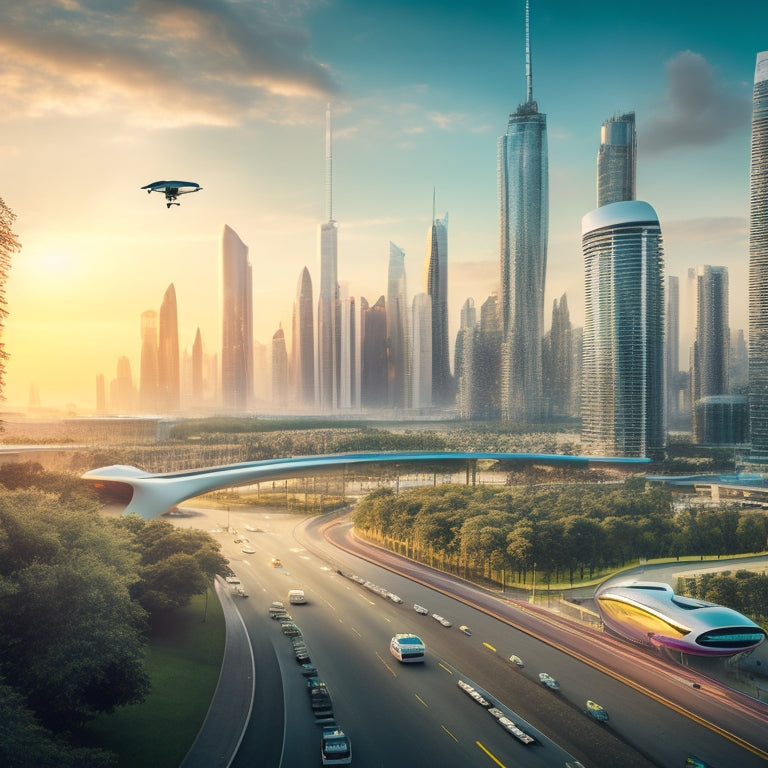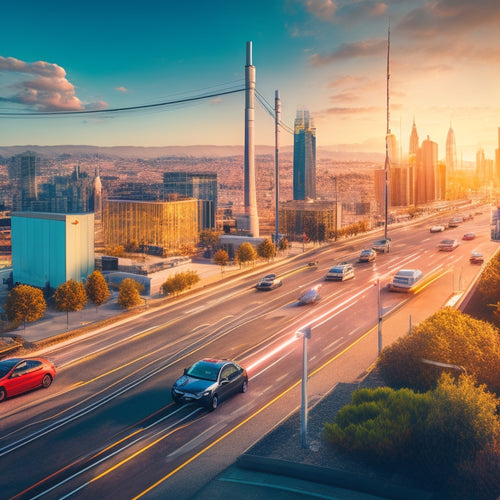
What's the Future of Urban Commuting?
Share
As you prepare to navigate the urban jungle, you can expect a seamless blend of sustainable transportation options, with over 20,000 public EV charging stations slated to dot urban landscapes by 2025, paving the way for a commuting revolution that's cleaner, greener, and more efficient. Electric bike rentals and bike-sharing models will become increasingly popular, while autonomous public transit systems improve route optimization and passenger safety. Smart traffic management and green infrastructure investments will also shape the future of urban commuting. Get ready to experience a transformed urban landscape that's driven by technology and sustainability - and there's more to explore ahead.
Key Takeaways
• Electric bike rentals and autonomous public transit systems will dominate urban commuting, reducing congestion and emissions.
• Integration of e-bikes, public transit, and Mobility as a Service (MaaS) will simplify urban travel, increasing flexibility and convenience.
• Advanced electric vehicle infrastructure, including rapid charging stations, will support widespread EV adoption, reducing urban air pollution.
• Smart traffic management, utilizing real-time data analytics and IoT sensors, will optimize traffic flow, decreasing congestion and travel times.
• Sustainable urban planning strategies, such as mixed-use development and green infrastructure, will create efficient, eco-friendly, and livable cities.
Electric Bike Rentals Rise
As you navigate through urban landscapes, you're increasingly likely to stumble upon electric bike rental stations, a trend that's rapidly gaining traction in cities worldwide. This growing phenomenon isn't only a reflection of the rising popularity of eco-friendly transportation but also a showcase of cities' efforts to promote sustainable living.
Electric bike rentals have become an integral part of community engagement, encouraging citizens to adopt a healthier, more environmentally conscious lifestyle. Additionally, this trend has also led to rural expansion, with many rural areas now offering electric bike rentals to tourists and locals alike. This expansion hasn't only boosted local economies but has also increased accessibility to scenic areas, promoting a deeper connection with nature.
As you explore these urban landscapes, you'll notice that electric bike rentals are no longer a novelty but a staple of modern urban living, fostering a sense of community and environmental stewardship.
Urban Mobility Solutions Evolve
Understanding the evolution of urban mobility solutions is crucial as you observe a shift towards more sustainable and efficient systems.
You're likely to come across electric vehicle infrastructure that supports widespread adoption, autonomous public transit that redefines traditional bus routes, and smart traffic management that optimizes traffic flow.
These innovations are transforming the urban commuting landscape, and it's important to grasp how they'll impact your daily commute.
Electric Vehicle Infrastructure
By 2025, you'll likely find yourself relying on a network of over 20,000 public electric vehicle charging stations across urban areas, a significant leap from the mere 1,600 available in 2018.
This rapid expansion of EV charging infrastructure is vital for widespread adoption of electric vehicles, which are expected to dominate urban roads in the near future. As you navigate through the city, you'll have access to fast and convenient charging points, making long-distance travel a breeze.
However, this growth also poses a challenge: managing the strain on the grid capacity. To address this, utility companies and policymakers are collaborating to make sure that the electrical grid can support the increased demand. This might involve upgrading infrastructure, implementing smart charging systems, and incentivizing off-peak charging.
As you plug in your vehicle, you'll be contributing to a more sustainable urban commuting ecosystem, and paving the way for a cleaner, greener future.
Autonomous Public Transit
You'll be stepping into a future where autonomous public transit systems, like self-driving buses and trains, will seamlessly integrate with other modes of transportation to optimize urban mobility. These advanced systems will prioritize Route Optimization, ensuring that your commute is faster and more efficient.
With enhanced Safety Features, such as collision avoidance and emergency response systems, you'll feel secure while traveling. The Passenger Experience will also undergo a significant transformation, with personalized services and real-time information at your fingertips.
Behind the scenes, Fleet Management will become more streamlined, allowing for more efficient scheduling and maintenance. As Autonomous Buses become the norm, Transit Hubs will evolve into vibrant, multimodal centers, redefining the urban landscape.
Imagine stepping off a self-driving bus and effortlessly transferring to a hyperloop or ride-sharing service, all while enjoying a seamless, hassle-free experience. With autonomous public transit, the future of urban commuting is poised to become safer, smarter, and more sustainable.
Smart Traffic Management
You're likely familiar with the frustration of sitting in traffic, watching the minutes tick by as you inch along. But what if you could avoid that congestion altogether? Urban planners and engineers are integrating advanced technologies, including real-time data analytics and IoT sensors, to optimize Smart Traffic Management systems, dynamically adapting to changing traffic patterns and pedestrian flows to minimize congestion and reduce travel times.
With real-time analytics, you'll be able to plan your commute more efficiently, receiving updates on traffic patterns and adjusting your route accordingly. This isn't just about reducing travel times; it's about creating a more sustainable, efficient transportation system.
By leveraging IoT sensors, cities can monitor traffic flow and respond to issues in real-time, reducing congestion and decreasing emissions.
As Smart Traffic Management systems continue to evolve, you can expect a seamless, stress-free commuting experience. With real-time data analytics guiding the way, you'll be able to navigate your city more easily, getting where you need to go quickly and efficiently.
The future of urban commuting is looking bright, and it's all thanks to the power of Smart Traffic Management.
Sustainable Transportation Takes Hold
As you explore the future of urban commuting, you'll notice a significant shift towards sustainable transportation systems.
You're likely to see a surge in electric vehicle adoption, substantial investments in green infrastructure, and a revamped public transit system that prioritizes efficiency and eco-friendliness.
These developments will play a pivotal role in reducing urban commuting's environmental footprint, and understanding their implications for the future of urban mobility is imperative.
Electric Vehicle Uptake
Rapid electrification of transportation infrastructure and decreasing battery costs are propelling electric vehicles into the mainstream, with many nations setting ambitious targets for EV adoption.
As you consider making the switch to an electric vehicle, you're likely weighing the pros and cons. Vehicle incentives, such as tax credits and rebates, can help offset the higher upfront cost. However, charging anxiety and range anxiety are common concerns. You might worry about running out of juice on a long trip or struggling to find a charging station.
Fortunately, advancements in battery life and charging technology are alleviating these concerns. Home charging is becoming more convenient, and public charging infrastructure is expanding.
But, as urban sprawl continues to shape our cities, it's important to make sure that EV adoption doesn't exacerbate congestion and pollution. By understanding the nuances of EV ownership, you can make an informed decision about joining the electric revolution.
Green Infrastructure Investments
Green infrastructure investments are transforming urban landscapes, positioning cities to accommodate sustainable transportation alternatives and alleviate the environmental footprint of traditional commuting methods.
As you navigate through cities, you'll notice the increasing presence of green corridors, which not only enhance aesthetics but also mitigate the urban heat island effect, reduce air pollution, and provide habitat for urban wildlife.
Urban forestry initiatives are also gaining traction, with cities recognizing the importance of tree canopies in absorbing carbon dioxide, reducing noise pollution, and improving mental health.
By investing in green infrastructure, cities can create more livable, resilient, and sustainable environments that support the well-being of citizens while reducing the strain on transportation systems.
You'll see cities incorporating green roofs, green walls, and urban parks, which not only provide recreational spaces but also help manage stormwater runoff, reduce energy consumption, and promote biodiversity.
As green infrastructure investments continue to grow, you can expect to see more cities embracing sustainable transportation alternatives, ultimately redefining the future of urban commuting.
Public Transit Revamp
As you step into the future of urban commuting, you'll notice a significant shift in public transit systems. Cities are overhauling their public transit systems to prioritize sustainability, introducing eco-friendly buses and trains that reduce emissions and operating costs. This revamp is an essential step towards creating a more environmentally friendly transportation network. You'll benefit from reduced air pollution, decreased traffic congestion, and lower greenhouse gas emissions.
The revamped transit systems will also address Transit Inequality, ensuring that all communities have equal access to reliable, efficient, and affordable transportation. Fare Reform is another key aspect of this overhaul, aiming to make public transit more affordable and equitable for everyone. By introducing fare structures that are fair and flexible, cities can encourage more people to ditch their personal vehicles and opt for sustainable transportation.
As you navigate this new era of urban commuting, you can expect a seamless, efficient, and eco-friendly travel experience that prioritizes your needs and the planet's well-being.
Electric Bike Sharing Models
You'll find electric bike sharing models are emerging as a highly efficient and cost-effective solution for urban commuters, offering a flexible and cost-effective solution for urban commuters, offering a flexible and sustainable transportation alternative. These models cater to diverse user needs, providing convenient and accessible transportation options.
| Model | Features | Benefits |
|---|---|---|
| Membership Models | Monthly/Annual fees, unlimited rides | Cost-effective, flexible plans |
| Pay-Per-Ride Models | Pay-as-you-go, per-minute pricing | Suitable for occasional users |
| Battery Swapping | Easy battery replacement, reduced downtime | Increased usage, reduced maintenance |
| Station-Based Models | Designated pick-up/drop-off points | Convenient, organized infrastructure |
| Free-Floating Models | Pick-up/drop-off anywhere | Maximum flexibility, convenience |
When choosing an electric bike sharing model, consider factors like pricing, convenience, and flexibility. Battery swapping, for instance, can significantly reduce downtime, increasing the availability of bikes for users. Membership models, on the other hand, offer cost-effective solutions for frequent users. As you explore electric bike sharing models, consider what matters most to you – convenience, cost, or flexibility – and choose the model that best fits your urban commuting needs.
Bike-Friendly City Infrastructure
To fully leverage the benefits of electric bike sharing models, cities must prioritize the development of bike-friendly city infrastructure. This includes incorporating dedicated bike lanes, secure parking facilities, and intelligent traffic management systems that optimize traffic flow and minimize cyclist risk.
As you navigate the city, you'll notice that bike lanes are an essential component of this infrastructure. They provide a safe and efficient way for cyclists to travel, reducing conflicts with motorized vehicles and pedestrians. Additionally, bike lanes can be designed to accommodate different types of cyclists, from casual riders to commuters, fostering a strong cycling culture.
Commuter Behavior Shifts
As you explore the future of urban commuting, you'll notice a significant shift in commuter behavior. Changing travel habits are influencing the way people move around cities, with many opting for alternative modes of transportation.
You'll see that shifting mode preferences, such as a rise in carpooling and ride-sharing, are also redefining urban mobility.
Changing Travel Habits
One significant consequence of the urban commuting revolution is that it has led to a profound shift in commuter behavior, with many individuals opting for alternative modes of transportation. As you navigate the urban landscape, you're not alone in reevaluating your daily routines. Cultural influence and social norms play a significant role in shaping your travel habits, with many opting for more sustainable and convenient options.
Travel psychology suggests that commuter stress is a significant factor, with urban density contributing to feelings of frustration and anxiety. However, with the rise of work flexibility, you're now more likely to choose a mode of transportation that aligns with your lifestyle choices.
For instance, you might prefer a more leisurely bike ride or a productive train commute, allowing you to multitask on the go. As you adapt to the changing urban commuting landscape, you're not just altering your daily routine – you're redefining what it means to be a commuter in the 21st century.
Shifting Mode Preferences
You're witnessing a seismic shift in commuter behavior, with a growing number of urban dwellers abandoning traditional modes of transportation in favor of more sustainable, flexible, and tech-enabled options. This shift is driven by changing commuter psychology, as people prioritize convenience, comfort, and environmental sustainability. As a result, travel attitudes are evolving, with commuters seeking mode flexibility and a seamless user experience.
Some key trends shaping this shift include:
-
Increased adoption of micromobility: Bicycles, scooters, and skateboards are becoming increasingly popular, offering a fun, flexible, and environmentally friendly way to navigate urban landscapes.
-
Rise of ride-hailing and car-sharing: Services like Uber and Lyft are changing the way we think about car ownership, offering an alternative to traditional car commuting.
-
Growing demand for public transit innovation: Commuters are calling for modern, efficient, and reliable public transportation systems that can keep pace with urban lifestyles.
-
Shift towards active transportation: Walking, jogging, and cycling are becoming more popular, driven by concerns about health, wellness, and environmental sustainability.
-
Integration of emerging technologies: Electric and autonomous vehicles, hyperloops, and advanced public transit systems are set to revolutionize urban commuting in the years to come.
Electric Bike Technology Advances
Twenty-first-century urban commuters are poised to benefit from significant electric bike technology advances, which have led to the development of more efficient, reliable, and affordable e-bikes.
As you consider switching to an e-bike for your daily commute, you'll appreciate the improvements in battery life, now lasting up to 100 miles on a single charge. Rapid charging capabilities mean you can top up your battery to 80% in under 30 minutes.
The latest gear systems provide seamless shifting, while increased motor power ensures you can tackle steep hills with ease. Frame design has also evolved, with sleek, ergonomic designs that fit your body perfectly.
You'll appreciate the comfort of larger wheel sizes (up to 27.5 inches) and advanced suspension systems that absorb bumps and vibrations. Reliable brake systems, including regenerative braking, guarantee your safety on the roads.
With these advancements, you can enjoy a smooth, efficient, and environmentally friendly commute that's tailored to your needs.
Integration With Public Transit
As cities invest in smart transportation infrastructure, e-bikes are being seamlessly integrated with public transit systems, allowing you to plan and pay for your entire commute, including bike-share services and transit fares, through a single platform. This integration enables a more efficient and convenient travel experience, making it easier for you to navigate through the city.
Some benefits of this integration include:
-
Simplified Fare Policies: No need to worry about separate payments for bike-share services and transit fares, as everything is taken care of through a single platform.
-
Streamlined Transit Hubs: E-bikes and public transit systems are now connected, making it easier for you to transfer between modes of transportation.
-
Increased Mobility: With e-bikes and public transit systems working together, you have more options for getting around the city.
-
Reduced Congestion: By providing alternative modes of transportation, cities can reduce congestion and make commuting easier for everyone.
-
Enhanced Sustainability: The integration of e-bikes and public transit promotes a more sustainable and environmentally friendly way of commuting.
Urban Planning for the Future
Urban planners must now rethink city infrastructure to accommodate the growing demand for sustainable and efficient transportation systems, prioritizing pedestrian-friendly and bikeable spaces that seamlessly integrate with public transit networks. As you navigate through the city, you'll notice the importance of urban density in shaping the commuting experience. Higher urban density often leads to more efficient public transportation, reduced traffic congestion, and increased city resilience.
| Urban Planning Strategy | Benefits | Challenges |
| Mixed-use development | Reduced travel time, increased walkability | Zoning regulations, land acquisition |
| Green infrastructure | Improved air quality, urban heat island mitigation | Limited funding, maintenance costs |
| Smart traffic management | Real-time traffic monitoring, optimized traffic flow | Data privacy concerns, infrastructure costs |
Mobility as a Service
You'll soon find that Mobility as a Service (MaaS) platforms, which integrate public, shared, and on-demand transport modes, promise to revolutionize the way you navigate cities. By providing a seamless travel experience, MaaS platforms aim to reduce reliance on personal vehicles, decreasing congestion and pollution in urban areas.
Here are just a few benefits you can expect from MaaS:
-
Personalized travel plans: With access to real-time data and advanced Data Analytics, MaaS platforms can optimize your route, reducing travel time and increasing efficiency.
-
Streamlined payments: No more hassle with multiple tickets or apps – MaaS platforms allow for convenient, cashless payments.
-
Increased flexibility: With MaaS, you can switch between transport modes effortlessly, ensuring you always have the best option for your journey.
-
Improved User Experience: Intuitive apps and interfaces make it easy to plan and book your travel, providing a hassle-free experience.
-
Environmental benefits: By promoting shared transport and reducing the number of privately owned vehicles on the road, MaaS platforms can notably decrease carbon emissions.
Frequently Asked Questions
How Will Increased Bike Traffic Affect Urban Road Congestion?
As you navigate the urban jungle, you'll notice increased bike traffic; to mitigate congestion, cities will optimize bike lanes and conduct traffic pattern analysis, ensuring a smoother ride for all commuters, you included.
Will Electric Bike Rentals Be Affordable for Low-Income Commuters?
As you weigh the benefits of electric bike rentals, you'll face equity concerns: will low-income commuters be priced out due to financial barriers, limiting accessibility and perpetuating transportation inequality?
Can Bike-Sharing Models Be Adapted for Rural Areas Too?
Imagine yourself pedaling down a winding rural road. Can bike-sharing models be adapted for rural areas too? You'll find that rural accessibility can be achieved by creating village hubs, where bikes are stationed, making transportation more convenient for rural residents.
What Role Will Autonomous Vehicles Play in Future Commuting?
You'll likely rely on autonomous taxis for daily commutes, but you'll need to think about how Vehicle insurance policies will evolve to cover these self-driving cars, and how it'll impact your personal premiums.
How Will Urban Planning Accommodate Increased Bike Parking Needs?
You'll notice urban planners incorporating Bike Stations as integral hubs, accommodating increased bike parking needs through strategic Urban Densification, ensuring efficient land use and seamless connectivity within the cityscape.
Related Posts
-

5 Key Components of EV Charging Infrastructure
When building an EV charging infrastructure, you'll need to focus on five key components. First, a reliable power dis...
-

What Makes Eco-Friendly Car Batteries a Smart Choice?
You're considering eco-friendly car batteries, and for good reason. They offer a trifecta of benefits that make them ...
-

Why Home Battery Deals Are Worth Buying Online
You're buying a home battery deal online for the same reason you wouldn't buy a car without researching online first....


